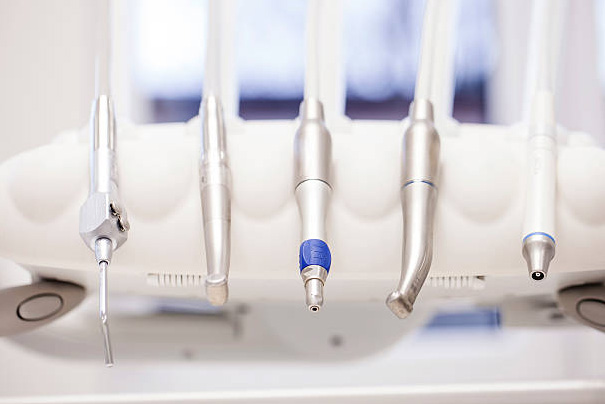High speed Handpieces:
High speed handpieces are the singular most important handpieces used by dentists in their practices. Whether you were in dental school, or took over another practice, I can guarantee that you have seen an air driven highspeed handpiece. They can be used for removal of tooth tissue efficiently with no pressure, heat, or vibration. It cuts the teeth easily. Their operational design is all of the same; they feature a spindle, a chuck, and bearings, which together make up a ‘turbine’. The spindles catch air pushed in through the air line, and creates the spin. The chuck is centered through the spindle, and allows the bur to be inserted and spun. The bearings attach the spindle and chuck to the head of the handpiece to allow everything to spin with little resistance and friction. Turbine are the main differences between differentHighspeed Handpieces models of handpieces. The spindles feature different sizes, and different amounts of teeth; which can create differences in torque, speed, and sound. The chucks are mostly the same mechanically. They come in different lengths, and different friction grip designs. The bearings come in special sizes and designs based off of the design of the head. Some bearings are larger or smaller, but the results are the same; they allow the turbine to spin without problems for as long as possible.
Low Speed Handpieces:
Low speed handpieces are most commonly used by RDH’s as they are the main handpiece used in polishing. They mostly all feature a vane motor, that allows a large portion of air to be retained within the vane to create greater torque, but less speed than highspeed handpieces. Most low speed handpieces spin at 20,000 to 5,000 RPM’s ( a ratio of 1:4). The 20,000 vane motors can integrate a geared reduction system that decreases the speed to 5,000, but increases the torque. This is great for removing caries as well as refining cavity preparations in endodontic procedures such as root canal treatments. Hygeniest’s love low speed handpieces as they grip the prophy cup well, and allow the handpiece to operate with a really easy to control speed.

Endodontic Handpieces:
The creation of endodontic attachments have made root canals so much easier than before. The offer rotating or reciprocating based off of your preferred file system. Most endodontic handpieces rotate at a greatly reduced speed (upwards of 64:1) which allows a great amount of torque for driving endodontic files with great precision. They are usually driven by an electric motor attached to an electric, endodontic based control system. This motor generally spins quietly at around 20,000 rpm’s, but is greatly reduced by the attachments.
Electric Handpieces:
Electric handpieces are highspeed handpieces bigger brother. They spin at a little slower speed than most air driven highpseeds, which is around 100,000-200,000 RPM’s. What they lack in speed, they make up for with torque. If you have ever used a air driven highspeed, you have felt the speed slow down when applying pressure to a tooth. This doesn’t happen with electric handpieces; you can push as hard as possible, and that handpiece will keep spinning and cutting. They are driven with an electric motor that attaches to an electric control system. They are a bit more pricey than most other handpieces, and a bit heavier. I would highly suggest trying before buying; they are truly a love-hate. Electric handpieces are all gear driven. They feature three main driveshaft systems, starting large, and ending small. You start with the dog drive, which attaches to the inner spindle in the motor. The dog drive attaches to the intermediate drive shaft, which increases speed and attaches directly to the geared spindle. There is no air involved, but inherently, with spinning gears you have more friction and heat.

